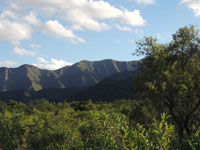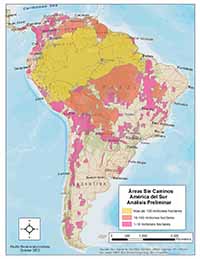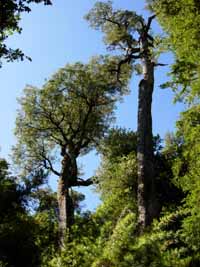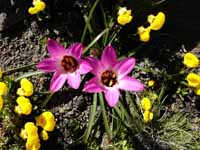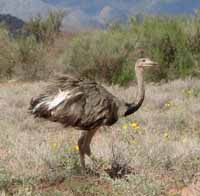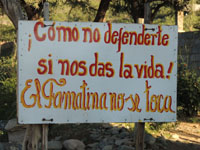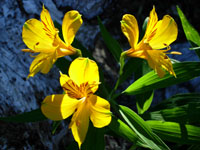South American Wildlands and Biodiversity
¿Habla español? Click aquí por una descripción del proyecto sobre áreas silvestres y biodiversidad.
 Learn about the spectacular biodiversity of the Sierra de Famatina
Learn about the spectacular biodiversity of the Sierra de Famatina
Why are we focusing our work on wildlands in South America?
Despite what you hear on the news about deforestation and habitat loss, South America still contains mind-bogglingly vast wild areas brimming with life. South America contains immense wildland and biodiversity resources that are unparalleled in today’s world. Yet, only a tiny fraction of the resources of the world's conservation organizations are focused on South America.
Pacific Biodiversity Institute has unique expertise that can aid in the protection of these most important biodiversity resources. Our mission and strategic plan motivates us to apply our energy to places that need the most help. Nowhere on the planet are the conservation opportunities as great and nowhere is there more need for high-quality conservation science and technical assistance. |
PBI’s initial mapping of the wildlands of South America has identified 5 roadless areas each over 110 million acres in size (each bigger than California) and 350 roadless areas each over one million acres. These spectacular gems are unmatched in today's world. Our initial mapping identified the largest area - the western Amazon - which is still one block of intact, pristine tropical forest of over 800 million acres! This vast tract of tropical forest, mountains, rivers and wetlands spans parts of 5 countries. It is bigger than 8 states the size of California placed end to end. And that is not all there is. In the eastern Amazon, another block of roadless, wildland remains that is over 300 million acres (three times the size of California). These immense wildlands are the heart and lungs of the Planet.
While these immense conservation opportunities still abound in South America, they are vanishing quickly due to human development and resource extraction. PBI has joined the urgent effort to protect as much as possible before it is gone forever. We are sharing information and inspiration with local, national and international conservation NGOs and scientists. With these esteemed partners and your help, we can insure that this most important biodiversity reservoir endures. The truth is: the future of mankind depends on it. We must recognize this need and act quickly. If these BIG wild areas and the plants and animals live there disappear, the future of the human race and the myriad other beings that share this beautiful planet with us will be very bleak.
The spatial magnitude of the wildlands in South America is just part of the story. These wildlands represent the core areas of the earth's most important biodiversity hot spots. For example, Conservation International describes the Tropical Andes biodiversity hot spot as “the richest and most diverse region on Earth”.
- “It is home to an estimated 30,000-35,000 species of vascular plants, accounting for about 10 percent of all the world's species and far surpassing the diversity of any other hot spot.”
- “The Tropical Andes harbor more than 1,700 bird species, nearly 600 of which are endemic, a level of endemism that is unequaled in the world.”
- “The Andes is the most important region in the world for amphibians, with around 980 species and more than 670 endemics.
- There are more than 600 reptile species identified in the Tropical Andes hot spot (more than 270 of which are endemic) and three endemic genera, a level of endemism unequaled in the world for this class.
And the Tropical Andes is just one of the many biodiversity hot spots in South America.
Wildlands Defined
Wildlands are places where ecosystems are still characterized by natural processes and where native biodiversity finds its fullest expression. Wildlands are areas without roads and have minimal human development. However, people (particularly in South America) may live within wildlands. Wildlands are for people as much as they are home to tremendous biodiversity.
Our Primary Goals
- Accurately map and describe the wildlands that remain in South America. This is the first step of any conservation effort. You can't protect an area that you can't describe.
- Develop a deep information resource containing data on the plants, animals, ecosystems, environments, human uses and threats to these wildlands. This information resource will be key to their protection.
- Characterize these areas in terms of their irreplaceability. What is their overall contribution to global biodiversity and what would be lost if they disappear?
- Characterize these areas in terms of their vulnerability. What are the pressures, threats and chances that they will be compromised or destroyed through fragmentation, development or biodiversity loss?
- Integrate this information in a wildland conservation decision support system that can be used to inform conservation decisions in South America.
- Share these rich information resources with conservation partners at all local, regional, national and international levels
- Help build capacity within regional partner NGOs and scientists through training and material support
Our Methods
- We are mapping and analyzing the roadless/undeveloped areas using a procedure we developed to map the wildlands of the USA in 2001. We have continued to improve these methods through successive iterations. This project is conducted in tandem with our Wildlands and Biodiversity in Washington State project, which provides a local test bed for development of analysis techniques and approaches.
- We work in close collaboration with talented partners at local, national and global levels. These scientists and conservationists provide valuable information, insight, inspiration and guidance.
- We gather the best available information about the wildlands of South America and their biodiversity from numerous sources around the world.
- We tap into a reservoir of enthusiastic and skilled volunteer citizen scientists and explorers.
Opportunities for Individuals
Help us map South American Wildlands from home.
Download and view a slide show on wildland conservation opportunities in Argentina and Chile with a perspective from North America. (Adobe Acrobat format) (7.7 MB)
Explore our growing collection of webmaps large wildland complexes in Argentina and Chile
Read a complete description of the project, including a work plan, timeline, and other details. (Adobe PDF file).
Read more about this project here
Copyright © Pacific Biodiversity Institute
